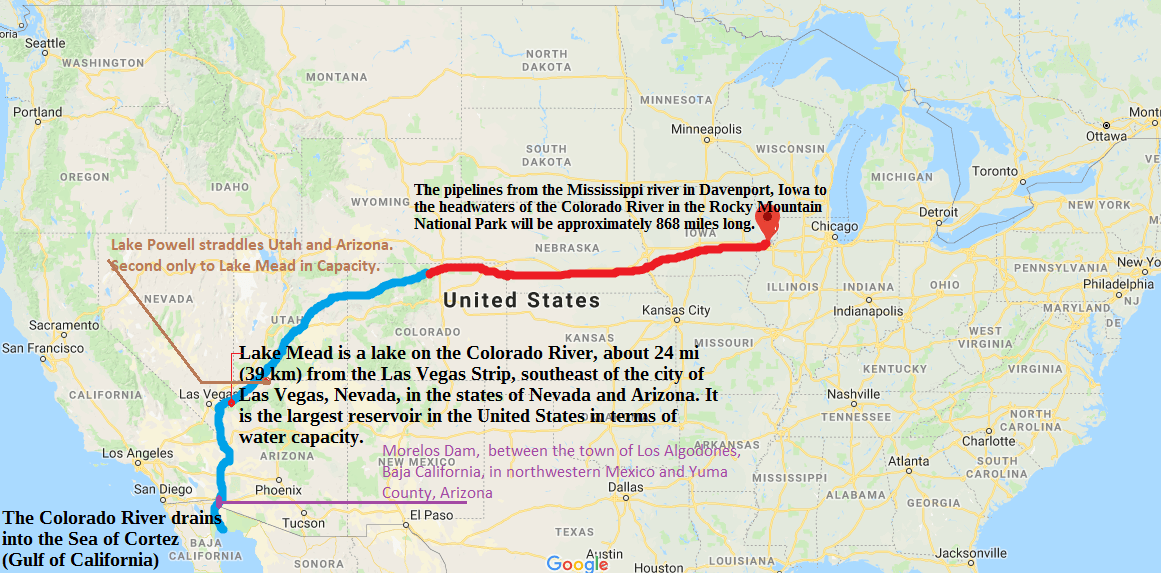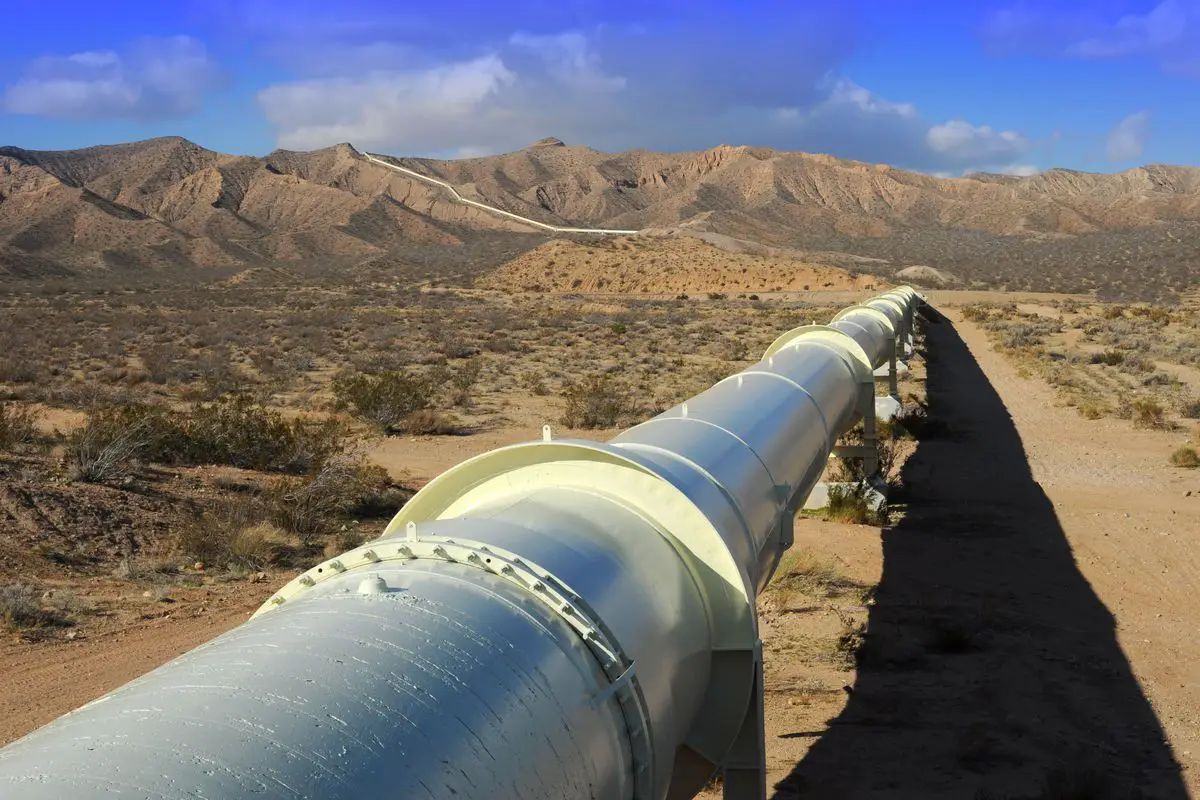Every day the rain doesn’t come, the solutions that sounded expensive and over the top now may be the only answer. One of them is piping water from other parts of the country that have too much rainwater to relieve California which has none. What is a Water Pipeline to California?
Proposals to build pipelines to pump Water to California & other Southwest states:
- Great Lakes to the Green River-Colorado River-2500 mi.
- Mississippi River-Davenport, Iowa to Colorado River Headwaters 868 mi.
- Columbia River, Oregon, Washington, Alaska, & British Columbia to Alturas, California-300 miles
The idea of using water pipelines is nothing new in California. In 2012 the Bureau of Reclamation investigated planned to bring water to a thirsty California using a pipeline from the mouth of the Columbia River on the Oregon-Washington border, importing icebergs, and using conventional seagoing tankers. Then in 2015, the California drought brought pipeline proposals back to the public consciousness, championed by celebrities like Rush Limbaugh and William Shatner
Water Pipeline From Great Lakes to California
The Colorado River supplies Arizona, California, Nevada, New Mexico, Utah, Colorado, Wyoming, and Mexico all share the river’s resources. However, the river is increasingly threatened by drought, with flows having dropped some 20 percent over the last two decades. Then add in the population growth of the Southwest that depletes water supplies for homes and businesses. With the main water usage being from agriculture the industry that these states depend on so much. The clock is ticking and everybody knows it!
The idea to move water from the Great Lakes to parts of the Green River-Colorado River and various other spots of mainly southern California, scientists and engineers projected a cost that could be in the neighborhood of would be approximately 250 billion to build the pipeline and that depends on differences in altitude where the pipeline would have to lift or go around obstacles to compensate for it. Then the high cost of energy to pump the water through the pipe daily 365 days a year.
The pipeline would have to be about 2500 miles long. This project would be the largest endeavor that our country has ever attempted.
Then there is the politics of the plan!
Who Owns the Great Lakes
The United States considers the Great Lakes the fourth seacoast, and the Great Lakes region is a dominant factor in the Canadian industrial economy. The lakes’ main source of legal protection comes from the Great Lakes Compact, an agreement between eight Great Lakes states that was further approved by Congress and signed by President George W. Bush in 2008.
The compact also includes Canada’s two provinces on the lakes, Ontario and Quebec, and its terms cannot be changed without the approval of all compact member state and provincial governments. These laws could be overturned as the need for water becomes direr.
All eight Great Lakes states have active Coastal Zone Management Act programs working on state-specific coastal issues. Illinois, Indiana, Michigan, Minnesota, New York, Ohio, Pennsylvania, and Wisconsin. Four of the Great Lakes Erie, Huron, Ontario, and Superior are split between the U.S. and Canada. Lake Michigan is entirely in the U.S. The Great Lakes.
The Great Lakes and its Basin are what they call a combination of science, engineering, and politics over the years. This is the reason why a lot of people believe that Piping water from here at the source would be extremely complicated even before a pipeline would be laid.
The Great Lakes are one of the world’s largest surface freshwater ecosystems. With 21% of the world’s supply of surface freshwater 84% of North America’s surface freshwater. The Great Lakes basin encompasses large parts of two nations, the United States and Canada:

According to NOAA– The Great Lakes span 4,530 miles of coast and account for 21 percent of the world’s freshwater. More than 30 million people rely on the Great Lakes for drinking water 10 percent of the U.S. population and 30 percent of the Canadian population.
The U.S. Great Lakes maritime economy supports 311,000 jobs spanning every sector, from tourism and recreation to marine transportation. This translates to $8.8 billion in wages.
All eight Great Lakes states have active Coastal Zone Management Act programs working on state-specific coastal issues. In addition, two national estuarine research reserves protect a combined 17,270 acres. The reserves are located on Lake Superior and Lake Erie.
Through the Coastal and Estuarine Land Conservation Program, state and federal programs have protected approximately 11,500 acres of land within the Great Lakes.
In this video, Bill Marr makes a pretty good argument (in his own way) comparing piping oil or natural gas and piping water long distances to areas of the country that really need it. Is it easy probably not but is it possible? America and other countries transport oil long distances why not water?
Will California Run Out of Water?
Yes, California will run out of water within 1 year, says, Jay Famiglietti, a NASA senior Water Scientist at the Jet Propulsion Laboratory. Data reveals that total H2O storage in Ca. has been declining since 2002 when satellite-based monitoring began, & groundwater depleting since the early 20th century. …………………………………………………… Read more
Water Pipeline From Mississippi River to California
Officials from the Southwestern region have gone to Congress to ask them for relief from drought conditions taking water from the Mississippi River and releasing it into the headwaters of the Colorado River system upstream from Lake Powell and Lake Meade. This would help Phonix, Las Vegas, and Southern California with population growth and the most water demand.
With any big projects comes some risk especially environmental and evasive species that find their way into an ecosystem where they create damage to existing areas. Reducing flows to the Mississippi River or basins could have a negative effect on the Louisiana Bayou which is responsible for flood control. Mega projects can affect river species and sediments that have been there for long periods of time.
The distance between the input of the Colorado River and the point where the pipeline would draw from is about 868 miles at St. Lewis Missouri but engineers think it’s feasible and can save the reservoirs like Lake Meade from drying up.
What Type of Water Rights are in California?
In California, water rights are based on a hybrid mixture of riparian & appropriative rights issued & managed by the state & federal government to benefit all Californians giving individuals & others the right to beneficially use underground & surface water subject to seasonal & drought conditions. ……………………………………………………………………… Read more
Who Owns the Mississippi River

Louisiana Purchase in 1803. Following the United States victory over Britain in the War of 1812 Following the United States’ victory over Britain in the War of 1812, the highly coveted Mississippi River officially and permanently belonged to the Americans.
All states (31 states) east of the Mississippi River have water allocation laws based on the Riparian Doctrine. Any waterway that can be used for navigation in its normal condition is considered navigable. If it is only used for intrastate commerce or transport, it is under the control of that state.
Today the Mississippi River Commission (MRC) was established by an Act of Congress on June 28, 1879. MRC, which is headquartered in Vicksburg, Miss., provides water resources engineering direction and policy advice to the Administration, Congress, and the Army Corp of Engineers in a drainage basin that covers 41 percent of the United States and parts of two Canadian provinces by overseeing the planning and reporting on the improvements on the Mississippi River.
Water Pipeline From Oregon to California
Taking water from the Columbia River which separates Oregon and Washington was considered for a while then scratched in the early 1990s. The Columbia is the fourth-largest river in the nation and has the greatest flow of any American river draining into the Pacific would not be easy or fast or cheap.
The plan was to divert water from Oregon, Washington, Alaska, and British Columbia to the Columbia River and then pumped through a 300-mile pipeline from the river through Oregon to a reservoir near Alturas, California
It would cost an incredible amount of money, many billions. It is uncertain at best whether California legally would be able to obtain water rights to water from Columbia. And there would be dozens, perhaps hundreds, of government agencies in three states and the federal government that would all have a say in it. This alone would take decades.
What is the California Delta smelt controversy?
The Delta Smelt is a nearly extinct tiny, silvery blue fish that feeds directly on the planktonic base of the food chain, & in turn, is food to larger fish & birds linking plankton & vertebrates that have been at the heart of a longtime war with agriculture over California’s H2O usage & diversion ……………………………………………………………….. Read more
JimGalloway Author/Editor

References:
Wayne State University-Great Lakes Water to Be Piped to the Southwest
Mississippi River Commission–About the MRC
